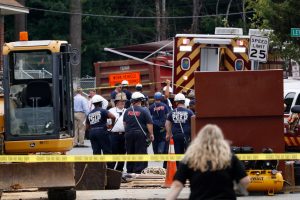
Just heard about a worker killed in a trench collapse about a dozen miles down the road from me. He was working for a contractor, Sagres Construction, which was working on a water main replacement project for the Washington Suburban Sanitary Commission (WSSC).
A few thoughts:
- The worker was apparently buried up to his chest. One might think that would be a good thing — if you’re head is out, you can still breathe, right? But those of you who are familiar with trench safety (or who read Confined Space) know that a cubic yard of soil weighs around 3 tons — the weight of a mid-size automobile. And a small automobile on your chest will kill you — either by crushing your internal organs, or making it impossible to to uncompress your chest to be able to breathe.
- The dangers of trenches have been know for thousands of years. Heroditus wrote about them 2300 years ago. OSHA has very good standards that would keep trench workers safe if followed. So why do workers continue to die in trenches?
- WSSC is the big utility in the Washington area. Why don’t they have some means to oversee their contractors to ensure that they’re in compliance with all OSHA regulations? And Sagres has already been cited by OSHA in 2014 and 2015 for trenching hazards. Why is WSSC contracting with them or at least why is WSSC not overseeing the contractor better?
- I wrote a while back about keeping an eye out for health and safety hazards in your neighborhood — especially ones that are easy to see, like deep trenches and workers on top of roofs without fall protection. This worker was killed in a residential neighborhood. How many neighborhood residents walked or drove by and saw the worker in the deep trench and either didn’t know it was dangerous or didn’t know what to do about it? How do we educate the public to confront managers or report these hazards to OSHA?
Meanwhile, on the other side of the planet, three workers were killed in a confined space incident in Saipan — the original victim and two rescuers — the largest of the Northern Mariana Islands in the Northern Pacific Ocean. The three were employees of USA Fanter which was contracted by the Commonwealth Utilities Corp. to install a new pump for a wastewater lift station. Why three fatalities? This was a confined space tragedy that used to be typical — before OSHA issued its General Industry Confined Space standard in 1992. One worker goes down into an unmonitored, unventilated manhole and passes out from hydrogen sulfide or oxygen deprivation. His buddy sees him, says “Oh my God,” and climbs down to help him. He is overcome, and HIS buddy sees him and repeats the deadly process. Before OSHA’s standard was issued, NIOSH had done a survey that found that more potential rescuers were killed in confined spaces than original victims.
This was not an “act of heroism and courage.” It was a miserable and criminal failure on the part of the employer.
A few thoughts here as well.
- Like trenches, the hazards of confined spaces — especially manholes where sewage or other organic material is likely to be rotting and exuding hydrogen sulfide — are well known hazards, especially to a company the size of Fanter. Why are these multiple fatalities still happening? No excuse.
- Fanter has received a number of OSHA citations over the past several years, although it is unclear if any of those were due to confined space hazards.
- And this always irritates me with confined space incidents : “[CUC legal counsel James] Sirok noted that two of the victims lost their lives attempting to save a coworker. ‘This is the ultimate act of heroism and courage for which they should be honored,’ he added.” These workers may have been courageous, but this was not an “act of heroism and courage.” It was a miserable and criminal failure on the part of the employer. One of the main principles of confined space safety is that there must be a method of non-entry rescue, and workers have to be well trained so that their heroism and courage isn’t a death sentence. And if the standard is followed, there should be no rescue needed, because contaminants are measured and the space is ventilated before anyone enters.The same principle applies in trench collapses. The co-workers’ first instinct is to jump down in a collapsed trench to dig their buddy out. But collapsed trenches have the tendency to continue collapsing, potentially creating more victims.
- These fatalities may have violated OSHA’s new construction Confined Spaces standard, issued just last year as part of the evil Obama tsunami of regulations that are allegedly killing the US economy. (if it had been issued in the Trump administration, two other worker protections would have had to have been removed.)
So what do all of these fatalities have in common? They were all well known hazards for which there are well known protections and they were therefore completely preventable. Both employers had been cited by OSHA before — one for the exact hazard that killed the worker. And both of these employers were subcontractors — one for a public utility. What responsibility to companies have to ensure that their contractors protect their workers?
This is a stark reminder of the consequences of scaling back enforcement of worker safety rules. According to the campaign rhetoric, regulators are “job killers.” But aren’t the folks that let employers violate confined space rules “people killers”? In an era of lax enforcement, too many employers are willing to risk the low probability of being caught, thereby jeopardizing lives. The “tone at the top” of this Administration will only exacerbate this trend. Worker safety and health regulations are not an abstract invention of academics or bureaucrats. These rules are common-sense measures designed to save lives based on empirical evidence.